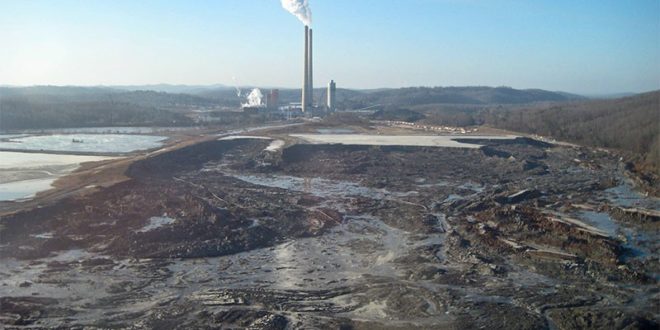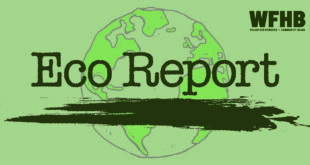Podcast: Play in new window | Download (Duration: 9:07 — 6.6MB)
A big reason for Indiana’s pollution is coal.
Coal has shown to be a very dirty and detrimental fossil fuel for the environment, one of the main causes to climate change.
Coal ash is the product of burning coal for electricity use. The waste product contains toxic chemicals such as arsenic, lead, mercury and selenium.
Indiana currently has the largest amount of coal ash disposal sites in the country.
Over the decades, this coal ash has reached and contaminated the groundwater of Indiana communities, making some water unsafe for drinking.
Background: How does this affect the environment?
According to southeastcoalash.org, the Environmental Protection Agency estimated that 72 percent of all toxic water pollution in the country comes from coal-fired power plants.
Indiana is known to be fairly coal-centered in terms of generating electricity for Hoosiers. And as in fairly, that’s 95 percent coming from coal.
The state produces between 32 and 35 million tons of coal per year.
Many officials have documented over 200 cases where coal ash pollutants were released into waterways surpassing state or federal standards.
One example is the case of Morgan County.
Exhibit A, Morgan County:
Morgan County, North of Bloomington, has been facing health effects caused by water contamination for years.
15 years ago the City of Martinsville added carbon filters to clean their main water source, however it seems that the filters are not stopping potentially dangerous chemicals from reaching drinking water and wells and affecting residents.
So what are the effects?
Well, when taking a look at the statistics of Morgan county versus the rest of Indiana, we can see some interesting results.
For the state of Indiana, 2018 cancer rates were shown at 470 people per 100,000 tested. Morgan County had 537 per 100,000 tested which made it the highest in the state.
Morgan County’s rates of other various types of cancer and rates of mortality from those cancers were all higher than the state rate.
The rate of childhood cancer in the county is 17.7 per 100,000 residents with the state average being 18.5, according to the National Cancer Institute.
As for the causes, many companies are hesitant to agree that they are environmental causes.
The Agency for Toxic Substances and Disease Registry came out with a report that said cancer risk for the majority of Martinsville residents was low and recommended residents to avoid drinking water from private wells. The EPA was noted also as an option for getting homes tested or removing chemicals if requested.
Mayor of Martinsville, Kenneth Costin answered concerns of pollution and mentioned the installation of new carbon filters to water systems saying that “Martinsville’s municipal water is safe to drink, and all testing has concluded that it is… the carbonization filtering that we do for removal of the contamination effectively removes the PCE to an undetectable level.”
History:
Going to the beginning of suspicion, Martinsville’s main water plume sits on a 38-acre property in downtown Martinsville. According to the EPA, the site used to hold Master Wear dry-cleaner which operated from 1986 to 1991.
Various complaints were made to the Indiana Department of Environmental Management between the same time frame for illegal dumping and mishandling of waste drums at the facility.
In 1991, a leak from the chemical processing equipment resulted in a fire at the facility.
One month after Master Wear closed, IDEM conducted an investigation and reported 44 55-gallon drums behind the building. Seven of them were labeled “perchloroethylene”.
Perchloroethylene or perc, is a nonflammable liquid solvent primarily used for dry-cleaning fabrics and in other industrial settings.
According to an article by the Indiana Environmental Reporter, it wasn’t until 1998 that the last of more than 7,400 gallons was finally removed from the property.
Some studies done by the American Cancer Society showed that some people exposed to perc also showed signs of cancer. However, other factors were not put into account such as cigarette or alcohol use.
The U.S. EPA ruled that dry cleaning machines must be rid of percs by December 21, 2020 in order to limit potential health risks.
The plume and former site of over 100 toxic drums is located less than half a mile from the city’s municipal well system.
The former dry cleaners and now water plume was added to the EPA’s National Priorities List and designated a Superfund site in 2013.
Last year, Doctor and environmental health scientist at Purdue University, Sa Liu partnered with environmental engineer retiree, Tom Wallace to conduct a health study in Martinsville.
Martinsville resident and alumni of Harvard University and Duke University, Tim Adams became a partner as well.
According to Liu, the health issues come initially from groundwater contamination which leads to toxic substances showing up in the air.
In December of 2019, the team collected water and air samples from homes of 20 volunteer residents.
Results from the tests were released in February during a community meeting with 100 attendees.
Toxic chemical PCE was found in 100 percent of the 10 water samples taken and 100 percent of the 39 exhaled breath samples tested positive for PCE.
Wallace said, “One of my very first conversations with Purdue about doing this was that we are not the only town like this… there are hundreds of them out there, and nobody knows what to do.”
He continued on to say, “If we do this right, and we do the proper testing step by step, the proper anthropological and sociological aspects, the environmental justice aspects of it, we will have a nice, concise template that any other city can just pick it up and plug in the pieces. You have this type of contamination, this how we did it, this is how you go ahead and do it for your town.”
Liu and Wallace have recently been selected for a $75,000 grant to study the effects of low-level, long-term exposure of PCE on children and developmental and neurological impacts.
The research team and others are now working on gaining grants for other projects, like testing private wells surrounding the Superfund site and creating a map of known cancer cases in town with the information.
They also would like high school students to be taught about monitoring air and taking water and breath samples at the local schools.
Solutions: Morgan County
According to Great Lakes Now, the EPA will release their final draft remediation proposal for the Pike Street plume this summer. It will be followed by a comment period for the public before the final review.
This will determine what type of funding and oversight should happen for the cleanup.
Currently, the EPA is doing a limited test remediation of 2 acres and periodic testing over a five-year period in the area.
Wallace stated, “The biggest element to overcome is the developing culture in this country of willful ignorance by the government and the public.”
Remediation work and cleanup won’t start for another 18 to 24 months and depending on how cleanup will be tackled it could take 9 to 34 years to completely repair the area.
As of July 14th this year, the EPA and IDEM have formally planned to put Morgan County area in federal air quality standards.
Solutions: US and Indiana
Although it may not be fast approaching, change is happening.
According to the IU Indiana Geological and Water Survey, U.S. coal production has dropped 37% in the last 10 years from over 1.7 billion to 800 million tons recorded in 2017.
Average concentrations of sulfur dioxide, which comes from burning coal, have decreased 82% from 2000 to 2019 thanks to air quality management and control strategies at local, state, regional, and national levels.
For the United States and even more so for Indiana, it’s going to be a struggle to stop relying on coal and start trusting renewable energy to be able to use with ease and be bought by the majority.
However, the struggles and health effects that coal is costing the US are making the transition more clear as a necessary step for the sake of a cleaner future.
 WFHB Bloomington Community Radio
WFHB Bloomington Community Radio


